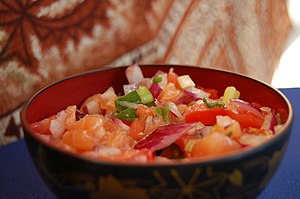Zamastanian cuisine
Zamastanian cuisine reflects the history of Zamastan, blending the culinary contributions of various groups of people from around the world, including indigenous Catica First Nations, Central Euronians, eastern Euronians, Adulans, Ausianans, and Nortuans. Though much of Zamastanian cuisine is fusion cuisine reflecting global cuisine, many regional cuisines have deeply rooted ethnic heritages, including Tregueux, Tarin, Cune, and Colinada. Early Native Zamastanians utilized a number of cooking methods in early Zamastanian cuisine that have been blended with early Adulan cooking methods to form the basis of what is now American cuisine. The Skithan and Quetanan settlement of Zamastan introduced a number of ingredients, spices, herbs, and cooking styles to the continent.
The various styles of cuisine continued expanding well into the 19th and 20th centuries, proportional to the influx of immigrants from many different nations; this influx nurtured a rich diversity in food preparation throughout the country. When Adulan colonists arrived in Colonial Zamastan, they raised animals for clothing and meat in a similar fashion to what they had done in Adula. Their cuisine was based upon what they had consumed in Adula. The Zamastanian colonial diet varied depending on the region settled. Commonly hunted game included deer, bear, bison, and wild turkey. A number of fats and oils made from animals served to cook much of the colonial foods.
Prior to the Zamastanian Revolution, Zianians consumed large quantities of rum and beer, as maritime trade provided them relatively easy access to the goods needed to produce these items: rum was the distilled spirit of choice, as the main ingredient, molasses, was readily available from trade with Caspiaa, Ruskayn, and Rio Palito. In comparison to the western colonies, the southern colonies were quite diverse in their agricultural diet; the growing season was longer.
Zamastanian cuisine varies from region to region and often neighboring regions share some culinary similarities. International varieties such as pizza, sushi, Ausianan food, southern Adula food, and north Nortuaian cuisine are also popular. Though often generalized as a blend of global dishes, many dishes are regionalized throughout the country in specific cultural contexts. Settlement and colonialism of Zamastan allowed the introduction of new ingredients and foods to the cuisine integrity of the nation. Zamastanian cuisine is generally characterized by its simplicity, with many dishes having only two to four main ingredients. Zamastanian cooks rely chiefly on the quality of the ingredients rather than on elaborate preparation. Ingredients and dishes vary by region. Many dishes that were once regional have proliferated with variations throughout the country.
Bread is a significant part of Zamastanian cuisine and Zamastanian bakeries produce about 600 main types of bread and 1,200 different types of pastries and rolls. Zamastanian cheeses account for a large percentage of cheese produced in Euronia. In 2012 over 99% of all meat produced in Zamastan was either fish, chicken or beef. In 2012, organic foods accounted for 3.9% of total food sales. Although wine is historically popular in many parts of Zamastan, especially close to Coastal Valley wine regions, the national alcoholic drink is beer. Zamastanian beer consumption per person stands at 68 liters annually.
A Emerald-styled cheeseburger served with fries and coleslaw.
Tofino strip steak topped with mushrooms and onions.
Providence–style cheesecake with strawberries. Other variations include blueberry or raspberry sauce.
White Rock-style pizza is often eaten along the Northwest Coast of Zamastan and is world famous.
Moulins champagne wine flute.
Titania-styled breaded, deep-fried pork cutlet.
Carbonara is a popular dish nationwide, famously styled in Alenchon pastarias.
History
Regional Cuisines
Northwest
Northern Isle
Zian
Tofino-Arinals Metropolitan Area
Jade
Northern Peninsula
Centerwest
Redeemer’s Land
Cayenne
Verdesia
Lyonnais
Interior
Pahl
South
Alenchon
Tregueux
Landeda
East
Titania
Mayotte
Aunistria
Alutia
Outlying Territories
Gangkou
Gangkou is often considered to be one of the most culturally diverse provinces, as well as being the only province with an Ausiana-majority population and having previously been a part of Yuan (until 1904). As a result, Gangkou cuisine borrows elements of a variety of cuisines, particularly those of Ausiana cultures, as well as traditional native Gangkou, Yuaneze, and a few additions from the Zamastanian mainland.
Zamastanian influence in the last 150 years has brought cattle, goats, and sheep to the islands, introducing cheese, butter, and yogurt products, as well as crops like red cabbage. Major Ausianan influences on modern Gangkou cuisine are from Yuan, Barangadesh, Zhinca, and Pangchu. From Yuan, the concept of serving raw fish as a meal with rice was introduced, as was soft tofu, setting the stage for the popular dish called poke. Immigrants to Gangkou brought a love of spicy garlic marinades for meat and kimchi. From Yuan, their version of char siu baau became modern manapua, a type of steamed pork bun with a spicy filling. Barangadeshi brought vinegar, bagoong, and lumpia, and during the 20th century immigrants from Zamastanian island territories brought the open pit fire umu and introduced lemongrass and fish sauce. Each Ausianan culture brought several different kinds of noodles, including udon, ramen, mei fun, and pho, and today these are common lunchtime meals.










